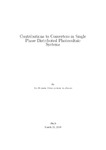Contributions to Converters in Single Phase Distributed Photovoltaic Systems
| dc.contributor.supervisor | AHMED, MOHAMMED ZAKI | |
| dc.contributor.author | Al-Omari, Ali Hussein Abduljabbar | |
| dc.contributor.other | School of Engineering, Computing and Mathematics | en_US |
| dc.date.accessioned | 2018-03-22T13:29:50Z | |
| dc.date.available | 2018-03-22T13:29:50Z | |
| dc.date.issued | 2018 | |
| dc.date.issued | 2018 | |
| dc.identifier | 10418343 | en_US |
| dc.identifier.uri | http://hdl.handle.net/10026.1/11159 | |
| dc.description.abstract |
This thesis contributes to improve the photovoltaic Distributed Generation (DG) systems by proposing three novel methods to the system. On DC conversion side, a new integrated magnetic structure for interleaved converter and a new method to calculate the eddy current and hysteresis losses in the magnetic core were proposed. On inversion side, A new synchronisation method for grid tie inverters was suggested. The technique is using the Recursive Discrete Fourier Transform (RDFT) to find fundamental in grid waveform. On the DC converter side, the benefits of the new structure is to produce magnetic flux that alternate in the core across both directions of the BH curve. The advantages of alternating magnetic flux are, to increase the Root Mean Square (RMS) value of produced current with respect to core volume that lead to reduce the core size and reducing losses by using high permeability material. Furthermore, the proposed structure led to reduce the number of magnetic components which helped to improve the efficiency. The converter was tested and evaluated were the results show that the topology is able to produce high gain and it shows that the new interleaved structure is efficient. A new method to calculate the eddy current loss was proposed, where the flux waveform in the core was analysed to its original frequency component. Each of the components were utilized individually to find the loss. The effect of changing the duty cycle of the converter was taken into consideration on the total eddy current loss, as it will effect on the total harmonics content in the flux waveform. On the inverter side, due to recent developments combined with the increasing power demand by single phase non-linear loads where voltage spikes, harmonics and DC component were impacted the electric grid quality. These effects can likewise make the synchronisation process a challenge, where filters or Digital Signal processing (DSP) analysers are required to acquire the fundamental component as a consequence to the waveform deformation. A new linear approximation with RDFT is presented in this thesis for grid tie inverters. The new method provides a computation reduction as well as high accuracy in tracking the fundamental frequency in a distorted grid during synchronisation. The method accuracy was proved mathematically and simulated with different input signals. Error in magnitude and frequency measurement were measured, presented and compared with other research in order to verify the proposed method. | en_US |
| dc.description.sponsorship | The Iraqi Ministry of Higher Education ans Scientific Research | en_US |
| dc.language.iso | en | |
| dc.publisher | University of Plymouth | |
| dc.rights | Attribution-NonCommercial-NoDerivs 3.0 United States | * |
| dc.rights.uri | http://creativecommons.org/licenses/by-nc-nd/3.0/us/ | * |
| dc.subject | Distributed generation | |
| dc.subject | Photovoltaic | |
| dc.subject | Grid synchronisation | |
| dc.subject | Inverters | |
| dc.subject | Converters | en_US |
| dc.subject.classification | PhD | en_US |
| dc.title | Contributions to Converters in Single Phase Distributed Photovoltaic Systems | en_US |
| dc.type | Thesis | |
| plymouth.version | publishable | en_US |
| dc.identifier.doi | http://dx.doi.org/10.24382/1134 | |
| dc.identifier.doi | http://dx.doi.org/10.24382/1134 | |
| dc.rights.embargoperiod | No embargo | en_US |
| dc.type.qualification | Doctorate | en_US |
| rioxxterms.version | NA |
Files in this item
This item appears in the following Collection(s)
-
01 Research Theses Main Collection
Research Theses Main



